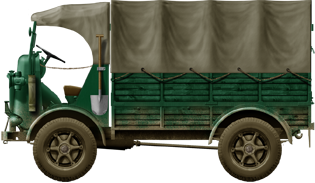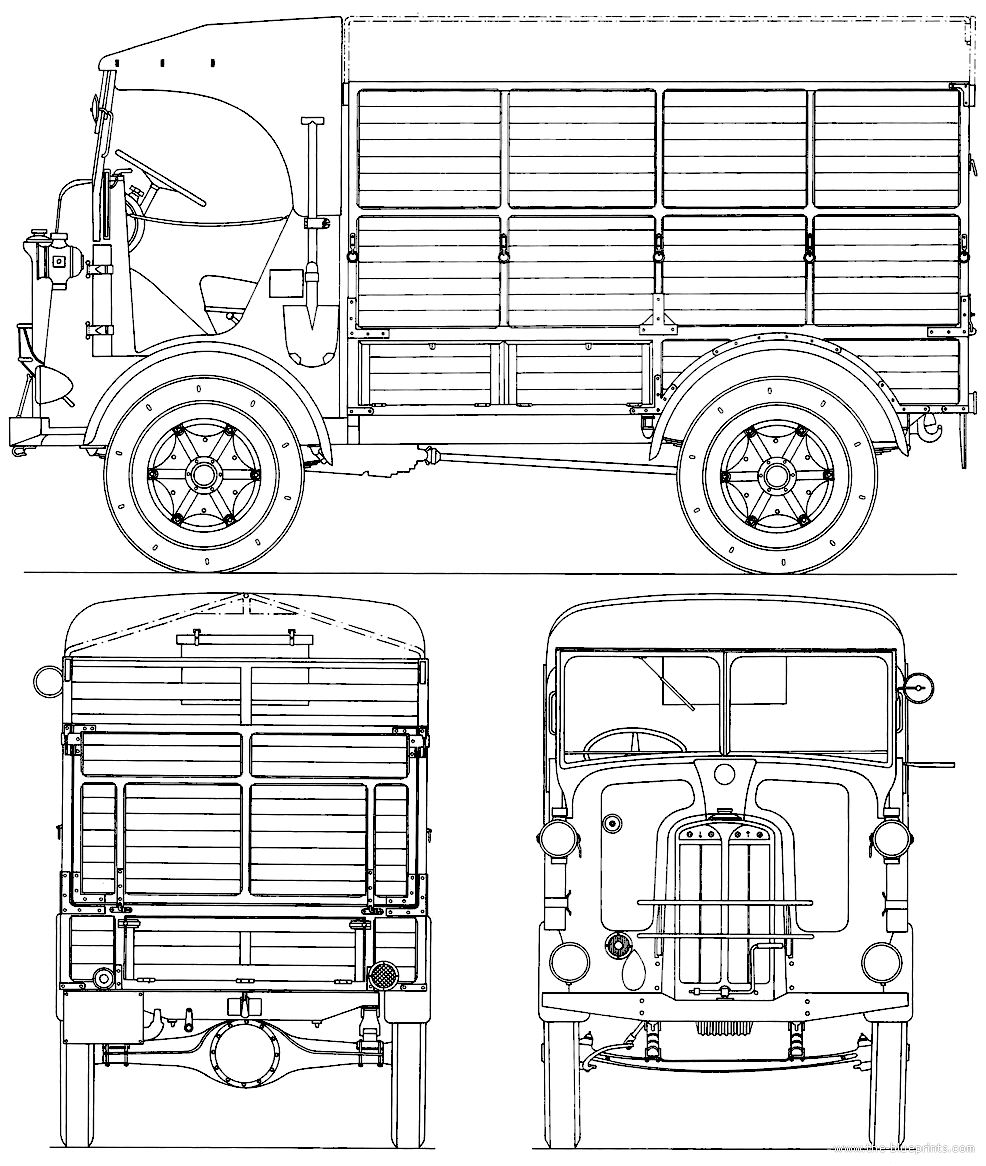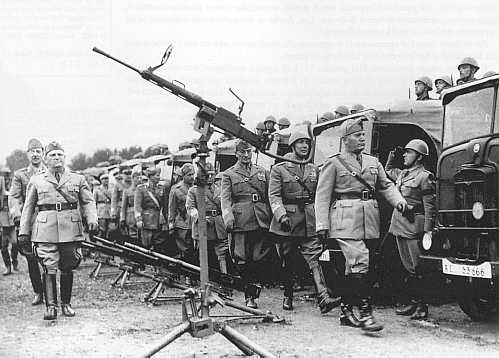FIAT SPA SPA-39
 Italy (1939) - Light Truck - 5,642 built
Italy (1939) - Light Truck - 5,642 built

The Fiat SPA CL-39 was designed as a more modern light lorry to complement the mountain truck, SPA OM series. It was largely produced and used on all fronts from Russia to the Balkans and North Africa. It's only variant was the Colonial version which had air conditioning, and the option of artillery tyres or regular pneumatics. With 5640 built until 1944 it became the most widespread of light lorries, distributed among mortar, howitzer, antitank and AA companies, used by the Regia Aeronautica as well.
Development
The SPA CL39 or Fiat-SPA CL39 or Fiat-SPA C.L.F. 39 ("Carro Leggero Infanteria") was also called the Autocarretta SPA and to differenciate it from the Autocara OM, the latter was made by the Società Piemontese Automobili (SPA). I was much smaller and used by the Regia Esercito and Aeronautcia. The CL 39 was not a light mountain truck, and its layout was less rustic.
It was however as easy to handle, and muc faster, still preserving its off-road caracteristics. SPA was in 1932 also absorbed by its main shareholder, Fiat, but was present on the market from 1906 to 1947. In 1909 the original company was already merged with F.L.A.G. (Fabbrica Ligure Automobili Genova). In 1926, financial difficulties had it purchased entirely by FIATand it became a part of "Fiat Consortium" since 1929, but ceased bus production in 1940. In 1947 it went bankrupt and definitively absorbed by Fiat.
 Autocarro Leggero SPA CL 39 in a museum
Autocarro Leggero SPA CL 39 in a museum
A new Lorry was asked for by the Italian Royal Army, a type of Light Infantry vehicle to replace animal-drawn battalion carts and mules, especially for travelling on mountain tracks. The Royal Army tested soon the OM Model 32, with several models derived. But alongside the development of a larger model started in the mid-1930s to support and replace the OM with a more modern and larger vehicle, for an intended larger supply contract.
The CL was developed in a first pre-serie, and in two versions:
-Air cooled engine
-Water-cooled engine.
Performances were compared when presented at the Motorization Study Center from 13 November 1938, and the water-colled powered version was selected. It was further developed by the Fiat Consortium under the code (later abandoned) of SPA 500. A few vehicles were tested in an experimental level both inside civilian companies and institutions, evaluating their characteristics and retaining design or material issues. But the CL surpassed all expectations and was soon versed on harder military evaluations, with some elements changed following indications of the MoD technicians, before beng approved and ordered, going into production in large numbers, both for the Army and Air Force whereas it was presented in parades and exercises in 1939, taking the acceptance name CL39. The "CL" for "Carro Leggero" was sometimes called the L39 truck. It soon found its proper use in many units and became widespread when WW2 started.
Design

Mechanics were considerably simplified compared to the Autocarretta OM for a higher production: The chassis was based on the same two side members, two axles, single wheels, nad the front ones steering, the rear axle providing traction. The wheelbase was extended to 2.3 meters and the track width to 1,320 metres, which procured a far better stability (Front track 1,30 m, rear track 1,32 m). Overall it was still very compact at 3,890 m, 1,520 m in width, 2,300 m in height. Ground clearance was 25 cm minimal. Fording 70 cm water was also possible.
The roadwheels could be fitted, like on the OM, with the "Artiglio" pneumatic tires (700-18”), or semi-pneumatic "Celerflex" 140x620 tyres. The engine was the liquid-cooled 4-cylinder in-line petrol SPA CLF engine with a capacity of 1,628 cm³, rated for 25 hp at 2400 rpm. Transmission used a simple telescopic cardan shaft with two cardan joints, and 5 speeds forward/1 reverse gearbox. There were hydraulic drum brakes on all four wheels.
To ensure better traction on the mud abd snow, the CL 39 was given special tracking chains that could be attached on the tres, stored in the com
partment located under the passenger seat, in the cabin. The parking brake acted also on the transmission, and its reverse stop mechanism could be activated by a lever close to the gear lever so to allow an up-hill or high slope start.
The cab was more advanced than on the OM. It had two seats, right-hand drive, but stayed open with canvas cover. The first 400 examples however were delivered with a hard roof before the productio was simplified. The flatbed received a wooden box with fixed side walls but tipping rear. Given the size of the CL39, it had a payload of 1,000 kgs or ten men, plus the two in cab. It was also equipped for towing loads up to 1.2 tonnes.
Suspensions were semi-elliptical springs, using normal compression. The Colonial version differed as having an added oil-filled air filter in the cab, to cool it down, and had a lowered body and spare wheel fixed behind the driver's seat, unlike the regular version.
Operational use
 Mussolini inspecting a unit of CSIR
Mussolini inspecting a unit of CSIR
The vehicle was intended to transport personnel and supply and to be used as artillery tractor, the Regia Aeronautica uing it for towing itq anti-aircraft machine guns Breda 20/65 Modello 1935 or the Scotti-Isotta-Fraschini 20/70, an the army, the anti-tank gun 47/32 Mod. 1935 as well as the howitzer 75/18 Modello 1934/1935.
From 1940, CL39s were assigned to howiter batteries, six, one of each 75/18 Mod. 34, and eight for 81 mm Mod. 35 mortar companies, four per 47/32 divisional anti-tank company. 1940 regulations precised each infantry division received 45 CL39s, and 1943 regulations had this increased to 145, so 53 per regiment, 39 divisional mortar battalions. The "Colonial" version was tested and adopted on 14 February 1941.
The Second World War saw them deployed on all fronts, including Russia, the Balkans, Italian Libya, but not Italian East Africa, which required even better off-road performances. After the armistice of 8 September 1943, some 198 were delivered under Wehrmacht control in 1944. Special versions were requisitioned, those equipped with all-wheel drive, based on the Spa 37 but without rear steering wheels. These were used until May 1945. After the war ended, the reliability made it stick to the Italian Army until the 1950s.
As the war progressed, they were equipped with Fiat 1900 cc engines, diesel oil fuelled, same as the Fiat 25 tractor, and with a starter coupled with an electric motor, powered by a 24 Volt battery. The older trucks had only crank-start but it was facilitated by a Marelli S.A.4 self-timer magneto. There was also also a three-brush dynamo to power the dashboard lights for ight drivinng. The external light were still the good old fashioned oil-filled models, and were the subject of "tactical darkening" (they were partly painted black).
Links about the CL-39
museodellaguerra.it
waralbum.ru
zinnfigur.com
video
o5m6.de/
track-link.com
on wikipedia.it
italie1935-45.com
3D
Amatori, Franco; et al. (1992). Storia della Lancia — Impresa Tecnologie Mercati 1906–1969. Milan.
Le Autocarrette del Regio Esercito, Nicola Pignato, GMT
Gli Autoveicoli del Regio Esercito nella Seconda Guerra Mondiale, Nicola Pignato, Storia Militare.
CL39 specifications |
| Dimensions | 3,89 x 1,52 x 2,30 m |
| Total weight, battle ready | 1,63 t - 3 tons with payload |
| Crew | 1+10 |
| Propulsion | SPA CLF gasoline 4 cyl. inline 1628 cm³ 25 hp, 15,34 hp/t |
| Top speed | 38 km/h |
| Payload | 1.5 ton |
| Transmission & suspension | 4×2 leaf springs |
| Maximum range (road) | 440 km |
| Production | 5,840 |